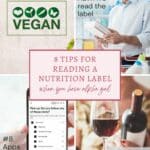
Understanding nutrition labels is essential for anyone who wants to make an informed decision about the foods they eat. But when you have alpha-gal syndrome, knowing how to read a nutrition label can be the difference between a delicious meal or snack and an emergency room visit.
The information provided on this site is based on my personal experience living with alpha-gal syndrome. I consistently cite and link to expert sources, but nothing published on this site should be perceived as medical advice.
Alpha-gal sensitivities vary by person. You should understand your dietary restrictions, making any adjustments needed, and directing any questions to your physician.
While several of the most common food allergens must be listed on food labels, alpha-gal isn’t one of them. At least not yet. So while it’s easy for folks with a dairy allergy to look for the telltale milk bottle icon or for people with a wheat allergy to spot a sprig of grains, there is no icon for us alpha gals. Additionally, many products that claim to be plant based or non-dairy can still include byproducts that are animal based, including those marked “vegan.” (More on vegan labels below.)
Sage Advice: Do you want alpha-gal added to the list of major food allergens regulated under the Food Allergen Labeling and Consumer Protection Act? Here’s where you can sign the petition to let your voice be heard.

To help offset the costs of running SageAlphaGal.com, you’ll find affiliate links lightly sprinkled throughout the site. If you choose to make a purchase via one of these links, there’s no additional cost to you, but I’ll earn a teeny tiny commission. You can read all of the legal blah blah blah (as my little niece says) on the full disclosure page.
In This Article
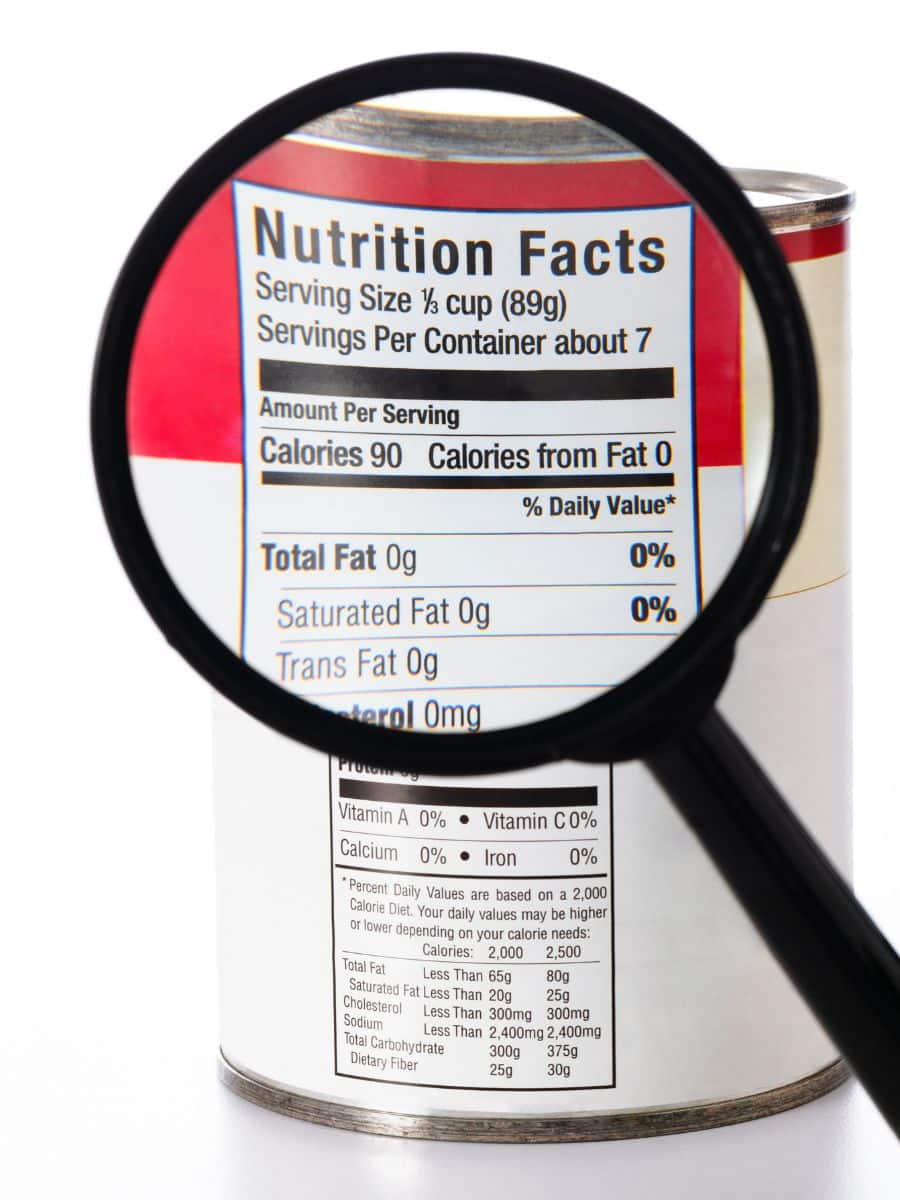
What is a Nutrition Label?
A nutrition label is an informational panel found on food packages. It includes important information about the calories, serving size, nutritional content, and ingredients. In the United States, the Food and Drug Administration (FDA) requires food manufacturers to follow certain labeling and manufacturing requirements if their products include one of these common food allergens:
- Milk
- Eggs
- Fish
- Crustacean shellfish
- Tree nuts
- Peanuts
- Wheat
- Soybeans
- Sesame
But if you have alpha-gal, it’s not so easy to separate products that are safe from those that might make you sick.
Want Alpha-Gal Safe Recipes and More?
Sign up for the weekly newsletter!
Thank You for Subscribing!
Understanding the Basics of a Nutrition Label
A food label comprises two separate sections: the nutritional information panel and the ingredients list. The nutritional information panel displays data such as serving size, calories, and the quantity of fat, carbohydrates, protein, and other nutrients in each serving. The ingredients list is typically found apart from (and frequently beneath) the nutritional information panel.
The list of ingredients details each component of the food product using its standard or familiar name. The ingredients are arranged in descending order based on their weight, meaning the heaviest ingredient is listed at the beginning, while the lightest ingredient is mentioned last.
With those basics out of the way, let’s get to the tips that will help you read a nutrition label when you have alpha-gal.
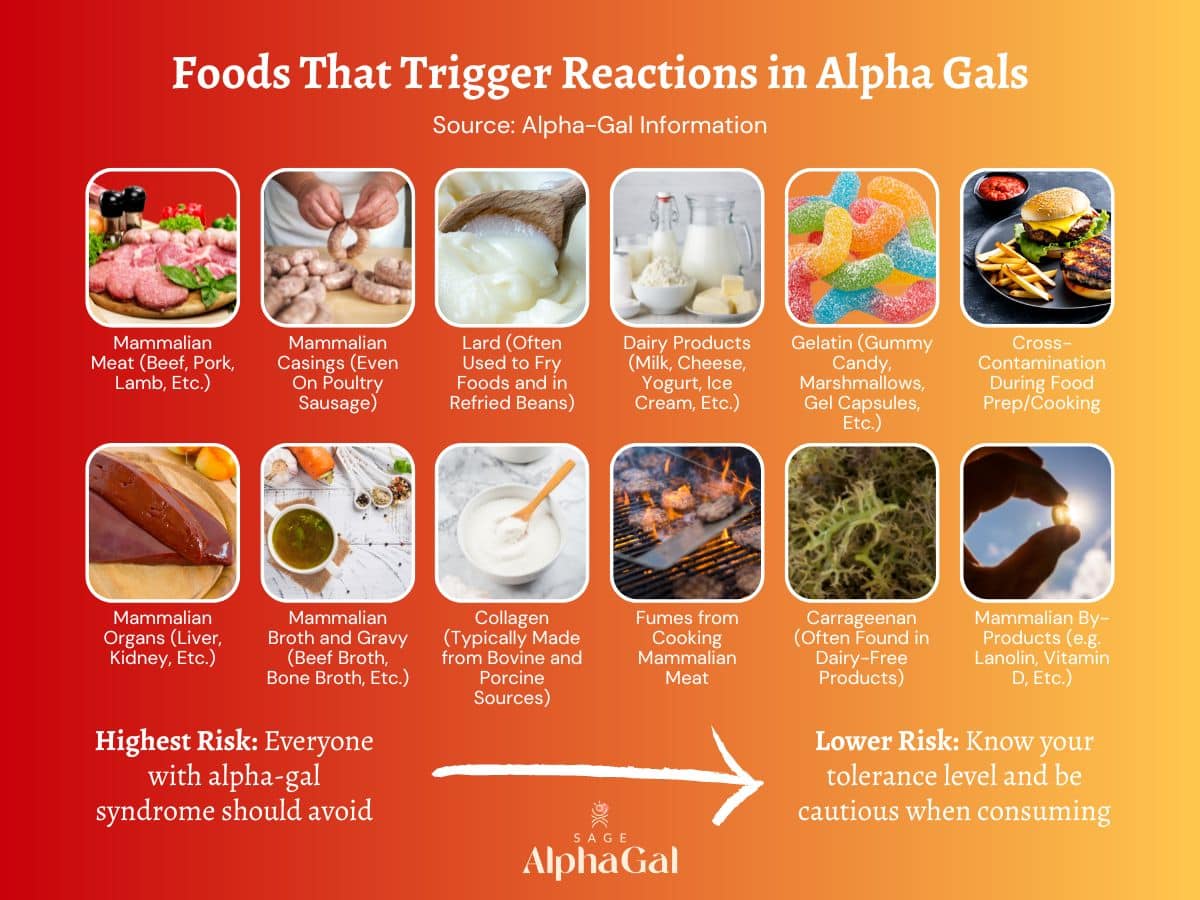
1. Know Your Tolerance Level
Alpha gals have different sensitivities to foods, and they can change over time. While all alpha gals need to avoid mammalian meats – like hamburger, bacon, and lamb chops – not everyone reacts to dairy or mammalian byproducts like gelatin, collagen, and glycerin. And alpha gals may have different reactions to these ingredients ranging from gastrointestinal issues to anaphylaxis.
If you don’t react to dairy, you can likely continue consuming products like skim milk, cheese, yogurt, and even ice cream. However, I recommend always choosing vegetarian cheeses when you have alpha-gal so that you’re not consuming varieties made with animal rennet. The American Academy of Allergy, Asthma & Immunology reports that most people with alpha-gal can tolerate “moderate, lean dairy.” But highly reactive alpha gals will need to avoid ingredients beyond pure meat products including bone broth, gelatin, and whey.
Sage Advice: As you work with your physician, this free food allergy trigger tracker can help you understand your tolerance level.
2. Always Read the Label
Even if you’ve eaten the product or sipped the beverage many times before, always read the label before you take a bite. Why? Because ingredients and manufacturing processes can change at any time and without warning. This means that the turkey bacon that was safe last month or even last week may not be OK today.
It’s also not safe to assume that a collection of products made by a single manufacturer is entirely alpha-gal friendly. For example, regular STARBURST original chews are not alpha-gal friendly because they include gelatin. However, mini STARBURST candies are made with pectin and carnauba wax and are safe for alpha gals to eat.

3. Watch for “Hidden” Ingredients That May Cause an Alpha-Gal Reaction
Although you know to avoid beef, pork, and other mammalian meats, alpha-gal allergy triggers aren’t limited to those obvious ingredients. They can be found in all sorts of other ingredients like collagen, gelatin, and glycerin. Even carrageenan, a plant-based ingredient, can cause reactions in some alpha gals. And just to keep you on your toes, some ingredients are known by several names.
Related Article: What is Carrageenan (And Why Should Alpha Gals Avoid It)?
So in addition to ruling out foods with obvious “universal” alpha-gal allergy triggers – like beef and pork – based on your sensitivity, you may also need to avoid foods with ingredients like:
- bone or meat broths (other than chicken)
- carrageenan
- flavorings (most used in savory products are often beef or pork based)
- gelatin (unless it’s certified Kosher)
- glycerin (unless it’s specifically listed as vegetable glycerin)
- lard
- marshmallows (unless they are kosher)
- milk and dairy products (like butter, cheese, yogurt, and ice cream)
- meat extracts
- vegetable gelatin (another name for carrageenan)
- whey
Sage Advice: If reading every label in detail is exhausting, try the Fig app. Not only is it programmed to help folks with alpha-gal syndrome avoid foods that will make them sick, but it can be customized to your sensitivity level. (Learn more about the Fig app in tip #8 below.)

4. Know That Some Allergy-Inducing Ingredients Aren’t Required to be Listed
While food in the United States is regulated by the FDA, alcoholic beverages are governed by the US Alcohol and Tobacco Tax and Trade Bureau (TTB). Try saying that fast three times after a glass of Merlot! That means that your favorite beer is subject to different labeling requirements than the bag of chips and jar of dip you purchase to eat while you sip your suds.
Why do you care? Because some brewers, winemakers, and distillers use gelatin (which is an allergy trigger for some alpha gals) to clarify their products. Fortunately, there’s Barnivore. Use this free app to identify beer, wine, and liquors that are vegan friendly, and you’ll know you can raise a glass without an allergic reaction.
Fun Fact: According to this article at Wine Spectator, there has been some push by the TBB to reconsider its current alcoholic beverage rules, but for now beer, wine, and spirit manufacturers are not required to list ingredients on their products.
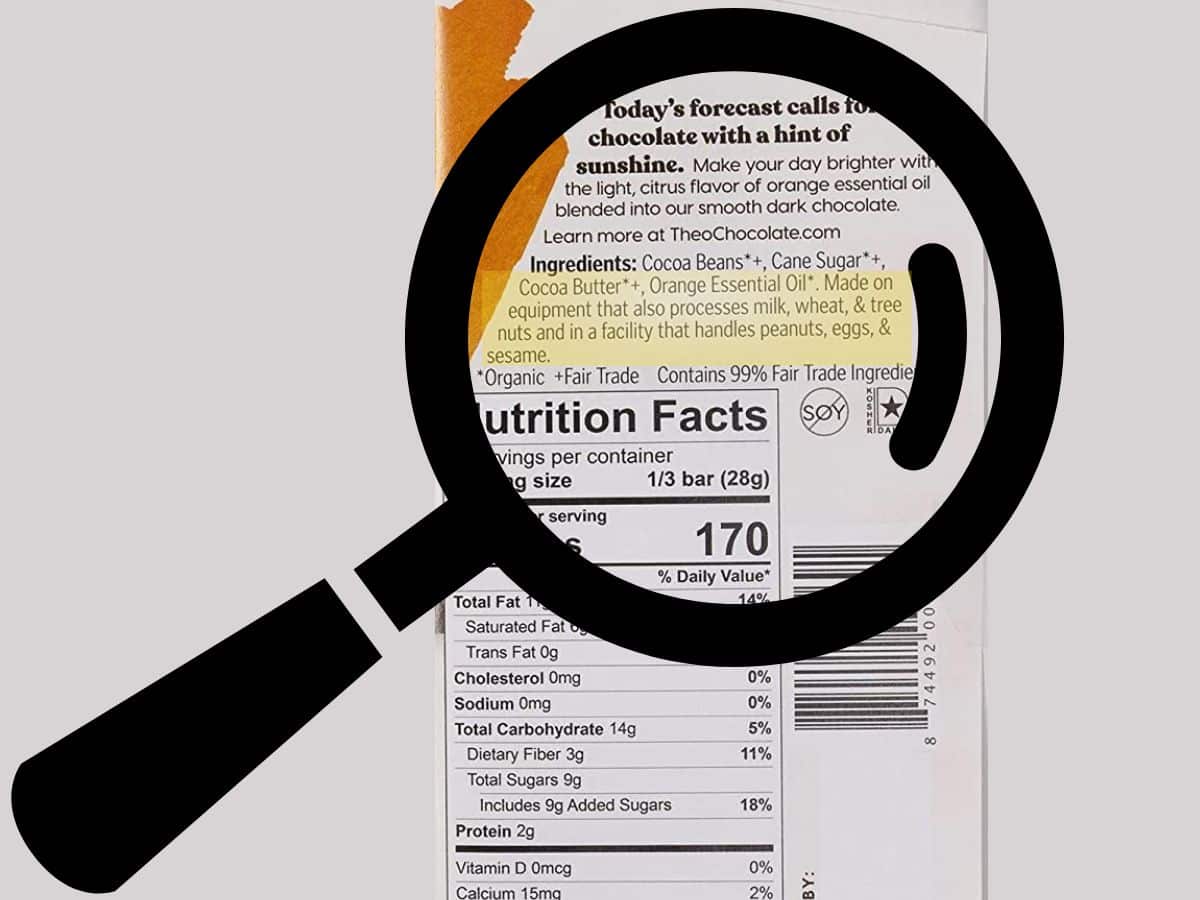
5. Be Mindful of Cross Contamination
If you are a highly reactive alpha gal, in addition to carefully reading the ingredients list, you’ll also want to watch for statements that indicate the potential for cross contamination. For example, a bar of dark chocolate may not include milk in the ingredients list. But if it’s made using the same manufacturing equipment that produces milk chocolate bars, there may be trace elements of milk in the dark chocolate bar.
These “may contain” warnings typically appear below the ingredients list with phrases like:
- “Made on equipment with …”
- “May contain traces of …”
- “Made on equipment that also processes …”
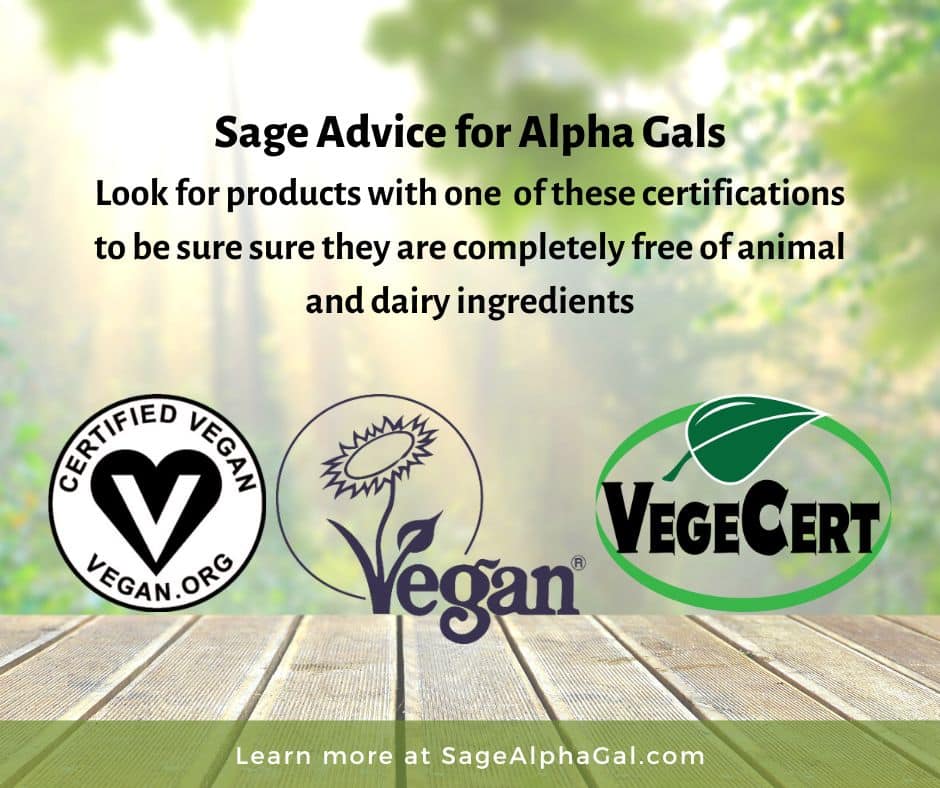
6. Don’t Automatically Trust Foods Labeled as Vegan
As mentioned above, products marketed as “vegan” may still include animal-based ingredients. That’s right! Because there is currently no federal legal definition of “vegan” in the United States, food manufacturers are free to use the term as they like. Until the U.S. Food & Drug Administration defines the term, to ensure that vegan foods are completely free of animal and dairy ingredients, look for products that have been certified by Vegan.org, The Vegan Society, or VegeCert.

7. Embrace Pareve Foods
If you’re not familiar with kosher foods, pareve is the Yiddish word used to describe kosher foods that aren’t meat or dairy. Pareve covers a wide range of foods, including fruits, vegetables, eggs, fish, and packaged goods. When you see the “OU” symbol (look for the letter u inside an o) or the “circle K” symbol (a “k” for “kosher” inside a circle), it helps you quickly rule out alpha-gal allergy triggers that are often hard to identify, like gelatin and bone char processed sugar.
Sage Advice: Pareve foods may still contain fish, eggs, or honey. While these are all alpha-gal safe ingredients, vegetarians and vegans will want to read the ingredient list carefully.
8. Let an App do the Heavy Lifting
While you can absolutely read nutrition labels to ensure that your food is alpha-gal friendly, it does take time and energy to do this for every single item you place in your grocery cart. And, there’s always a chance you’ll overlook an ingredient (especially on products with a long list of them) or won’t know what’s in a “natural flavoring” that can trigger a reaction.
When you use an app like Fig, you can let it do a lot of the work for you. One thing that I love about this tool is that you can select your level of alpha-gal sensitivity by ticking the foods you need to avoid:
- Mammalian meats
- Mammalian by-products
- Gelatin
- Dairy products
- Carrageenan and algae
- All of the above

So if you are an alpha gal that can safely consume dairy or who isn’t bothered by carrageenan, you can leave those options unchecked.
Once you have the app set to your alpha-gal sensitivity level, simply scan the barcode of any grocery store item to quickly identify foods that are alpha-gal friendly (or rule out the ones that aren’t) using a stop light system of green (can eat), yellow (limit this), and red (avoid).
How Do You Ensure Your Food is Alpha-Gal Friendly?
Do you have any additional tips and tricks to pass along to help fellow alpha gals make allergy-friendly food choices? Share your experiences in the comments section below.
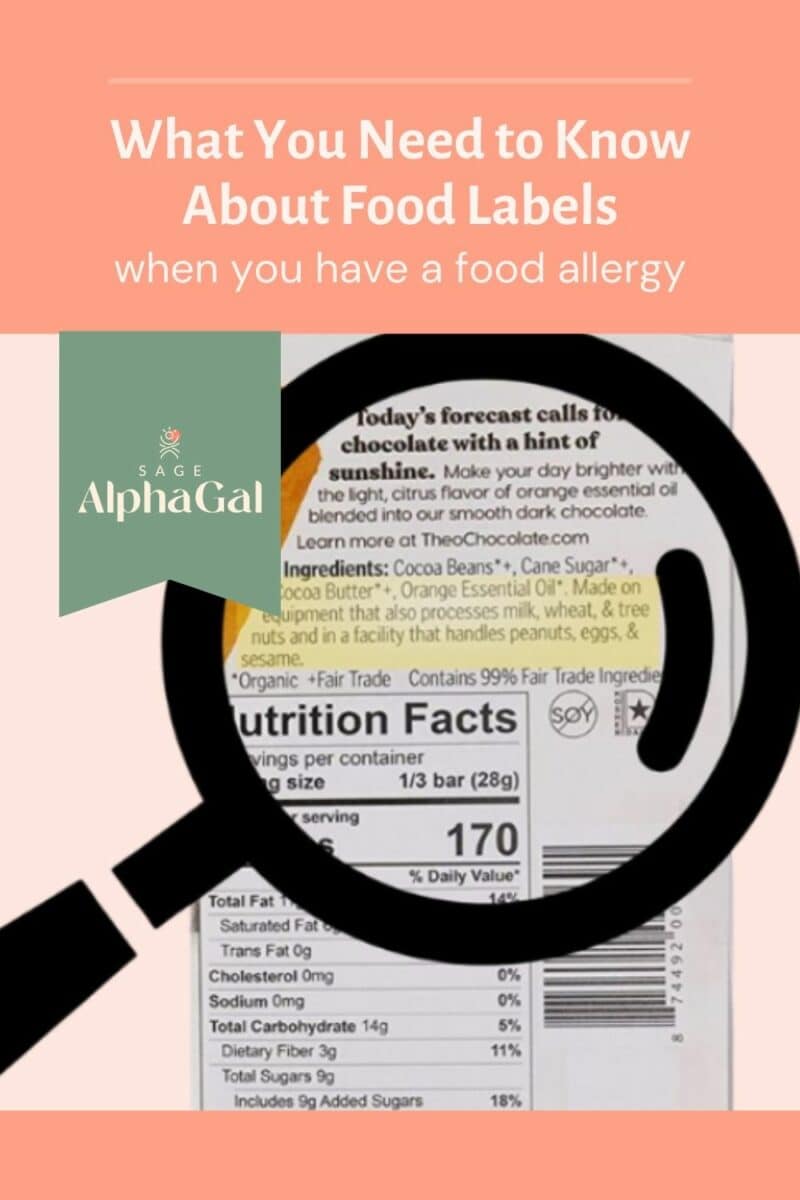

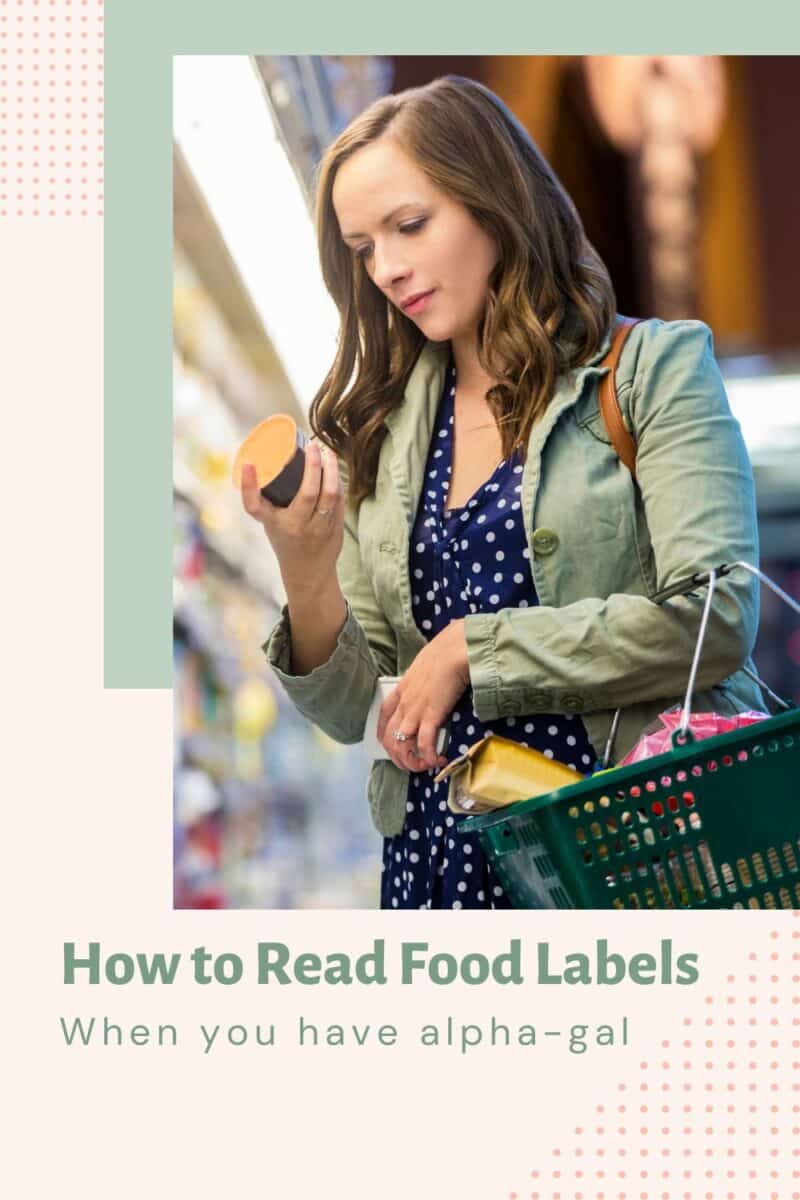
Thank you for sharing!
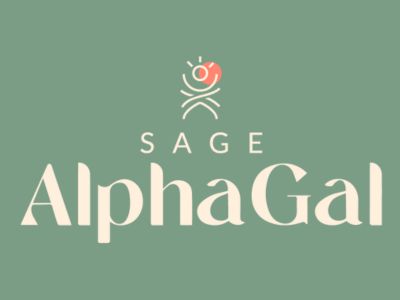

If it’s dairy free watch out for carrageenan.
I look for it on every label. ESP if a food is dairy free or low fat.
Yes! Such an important reminder. Thanks for sharing, Sharon!